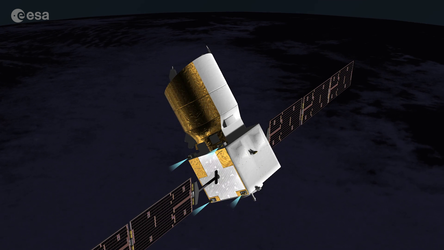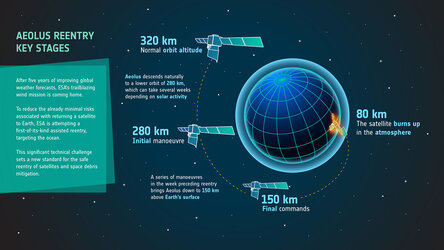Accept all cookies Accept only essential cookies See our Cookie Notice

About ESA
The European Space Agency (ESA) is Europe’s gateway to space. Its mission is to shape the development of Europe’s space capability and ensure that investment in space continues to deliver benefits to the citizens of Europe and the world.
Highlights
ESA - United space in Europe
This is ESA ESA facts Member States & Cooperating States Funding Director General Top management For Member State Delegations European vision European Space Policy ESA & EU Space Councils Responsibility & Sustainability Annual Report Calendar of meetings Corporate newsEstablishments & sites
ESA Headquarters ESA ESTEC ESA ESOC ESA ESRIN ESA EAC ESA ESAC Europe's Spaceport ESA ESEC ESA ECSAT Brussels Office Washington OfficeWorking with ESA
Business with ESA ESA Commercialisation Gateway Law at ESA Careers Cyber resilience at ESA IT at ESA Newsroom Partnerships Merchandising Licence Education Open Space Innovation Platform Integrity and Reporting Administrative Tribunal Health and SafetyMore about ESA
History ESA Historical Archives Exhibitions Publications Art & Culture ESA Merchandise Kids Diversity ESA Brand Centre ESA ChampionsLatest
Space in Member States
Find out more about space activities in our 23 Member States, and understand how ESA works together with their national agencies, institutions and organisations.
Science & Exploration
Exploring our Solar System and unlocking the secrets of the Universe
Go to topicAstronauts
Missions
Juice Euclid Webb Solar Orbiter BepiColombo Gaia ExoMars Cheops Exoplanet missions More missionsActivities
International Space Station Orion service module Gateway Concordia Caves & Pangaea BenefitsLatest
Space Safety
Protecting life and infrastructure on Earth and in orbit
Go to topicAsteroids
Asteroids and Planetary Defence Asteroid danger explained Flyeye telescope: asteroid detection Hera mission: asteroid deflection Near-Earth Object Coordination CentreSpace junk
About space debris Space debris by the numbers Space Environment Report In space refuelling, refurbishing and removingSafety from space
Clean Space ecodesign Zero Debris Technologies Space for Earth Supporting Sustainable DevelopmentApplications
Using space to benefit citizens and meet future challenges on Earth
Go to topicObserving the Earth
Observing the Earth Future EO Copernicus Meteorology Space for our climate Satellite missionsCommercialisation
ESA Commercialisation Gateway Open Space Innovation Platform Business Incubation ESA Space SolutionsEnabling & Support
Making space accessible and developing the technologies for the future
Go to topicBuilding missions
Space Engineering and Technology Test centre Laboratories Concurrent Design Facility Preparing for the future Shaping the Future Discovery and Preparation Advanced Concepts TeamSpace transportation
Space Transportation Ariane Vega Space Rider Future space transportation Boost! Europe's Spaceport Launches from Europe's Spaceport from 2012Latest

Sentinel-1B reentry phases
Thank you for liking
You have already liked this page, you can only like it once!
Preparations for Sentinel-1B’s disposal began in September 2022, right after the mission ended.
Building on their shared commitment to reducing space debris, a collaborative effort between experts from ESA, the European Commission, as well as industrial partners led to a well-structured disposal plan that maximised the satellite's remaining potential.
The plan, based on ESA’s previous satellite disposal experiences, involved multiple stages that allowed the ESA team to monitor and adjust as needed, after which the reentry itself will be uncontrolled:
- Orbit clear-up: Sentinel-1B’s orbit was lowered by a few kilometres to free up the orbit for the arrival of Sentinel-1C and Sentinel-1D satellites.
- Manoeuvre testing: New manoeuvres were tested and validated to complement conventional ones, and lower altitude much further.
- Active orbit lowering: The spacecraft was placed it in a final orbit, from which it will naturally decay and eventually burn up in the atmosphere.
- Passivation: The spacecraft was passivated, to remove as much stored energy as possible to avoid accidental breakups, and all powered systems were actively shutdown.
Disposal operations for Sentinel-1B began in February 2023, as planned. For the first six months, the operations went smoothly but as the orbit lowering progressed the teams had to overcome multiple challenges to stay on track. In April 2024, the final orbital altitude was reached, allowing for re-entry within 25 years. Electrical passivation took place on 12 September 2024, marking the end of the satellite’s operational life.
This careful operation helped gather useful knowledge about the spacecraft's capabilities and limitations, which will facilitate future Sentinel-1 operations for years to come.
Read full story: Sentinel-1B journeys back to Earth
-
CREDIT
ESA -
LICENCE
ESA Standard Licence

Aeolus reentry: the breakdown

ERS-2 reentry – how and why is it happening?

Saying goodbye to ERS-2

Key stages in Aeolus’ reentry















 Germany
Germany
 Austria
Austria
 Belgium
Belgium
 Denmark
Denmark
 Spain
Spain
 Estonia
Estonia
 Finland
Finland
 France
France
 Greece
Greece
 Hungary
Hungary
 Ireland
Ireland
 Italy
Italy
 Luxembourg
Luxembourg
 Norway
Norway
 The Netherlands
The Netherlands
 Poland
Poland
 Portugal
Portugal
 Czechia
Czechia
 Romania
Romania
 United Kingdom
United Kingdom
 Slovenia
Slovenia
 Sweden
Sweden
 Switzerland
Switzerland
























